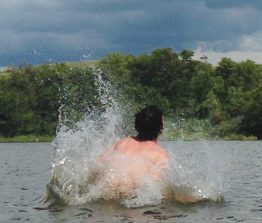Lake Effect
I swam in Chain Lakes this past summer for the first time since I was nine. The Chain Lakes I know is a string of three tiny lakes in Southwest Manitoba, just off Highway 21 between Hartney and Deloraine. My family’s farm – the place I grew up and where my brother and his family now farm – is beside the biggest of the three lakes. I shed sweat and dust in that shale-bed lake one sunny Prairie day in July.
My boys, my parents and I were camping in a sweet 1980s motorhome. My dad, taking a break from picking an ice cream pail of the plumpest, sweetest wild Saskatoons, decided he was roasted and it was time for a dip. We thought he was nuts.
Chain Lakes are shallow and weedy and muddy and leechy. I took two years of swimming lessons there, earning my white and orange badges. But as soon as Hartney built its centennial pool, all lessons and most swimmers’ loyalties shifted to the clear, treated waters. The weathered Chain Lakes change rooms (with their swallows’ nests) and the weird, wheeled diving platform were dismantled. Only diehards like my dad kept swimming there.
Yet here we were, playing catch on the shore and staying super-surface in a canoe, watching in awe as this fit older dude cannon-balled into the weeds. So what could we do but follow? One by one we de-calmed the waters. And – surprise! – it wasn’t as weedy or mucky or leechy a s anyone expected. It was great – just three feet deep – but great. We were experiencing a classic Mark Twain or W.O. Mitchell “swimmin’ hole”.
s anyone expected. It was great – just three feet deep – but great. We were experiencing a classic Mark Twain or W.O. Mitchell “swimmin’ hole”.
This maybe isn’t much of a story, but it reminded me again that you, as a farmer, work, live and play in the local environment you keep. This should be important to anyone questioning whether farmers care about the land. Of course you do. Which is something the non-farming 98-per-centers need to hear.
Sandi Knight wrote and Suckerpunch Creative designed this issue’s excellent infographic about “Honest engagement”, with tips for talking
science and modern agriculture. One tip is to appeal to people’s emotions rather than bombard them with facts. You appeal to emotions by talking about shared values and common concerns – about your ethics, experiences and priorities.
Be honest and authentic. Tell real stories.

Marketing man Terry O’Reilly, who hosts “Under the Influence”, one of my favourite radio shows on CBC, spoke at FarmTech 2016 in January. He said the same thing. People connect when you tug at their hearts. The best marketing pitches tell a story.
When someone challenges you about modern farming, you could say “Yes, I use these high-tech tools because they help me do a better job of producing food AND they also help me sustain my way of life, my land and the environment I live in.” Then share, with enthusiasm, something about your farm that they can relate to. Tell them about all the wild saskatoons growing in a bush at the end of your lane. Or the ducks and night-herons and muskrats in the wetlands you protect. Or why your grandparents chose this homestead five generations ago. Or about the little lake where your kids cool off on hot, dusty summer days.




